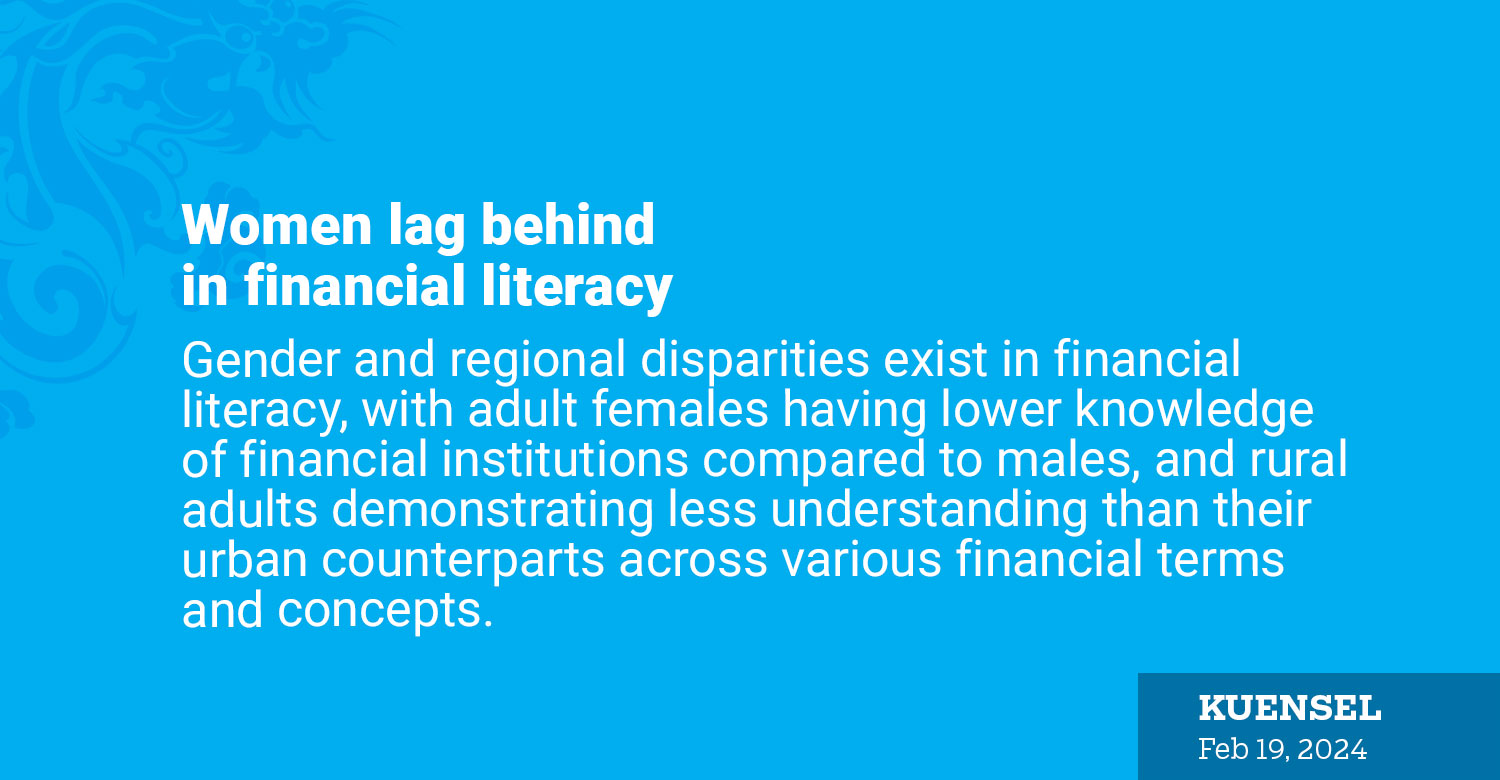
Gender and regional disparities exist in financial literacy, with adult females having lower knowledge of financial institutions compared to males, and rural adults demonstrating less understanding than their urban counterparts across various financial terms and concepts.
Royal Monetary Authority’s “Access to Finance Demand Side survey” conducted in 2022 and published last year targeted 7,200 households in 20 dzongkhags and estimated adult population to be 448,865 with 57.1 percent or about 250,000 females and 42.9 percent or about 190,000 males.
Adult females consistently exhibited lower levels of knowledge regarding financial institutions compared to their male counterparts. Notably, when queried about their comprehension of the functions of financial entities such as stock exchanges, microfinance institutions, and central banks, females reported significantly lower familiarity with the stock exchange (91.2 percent), compared to 88.4 percent of adult males.
Similarly, 82.5 percent of adult females, compared to 80.7 percent of adult males, expressed low knowledge of microfinance institutions.
These findings suggest the need for improved financial literacy and education initiatives to enhance the understanding of various financial institutions among the Bhutanese adult population. By increasing knowledge about the functions and benefits of these institutions, individuals can make more informed financial decisions and better utilise the available financial services to secure their financial future, according to the survey.
The study reveals that rural adults have less knowledge of financial institutions compared to their urban counterparts, especially in the stock exchange and central bank. In rural areas, 82.8 percent of respondents expressed a “very low” understanding of the stock exchange compared to 66.9 percent in urban areas, and 62.9 percent of rural respondents expressed “very low” understanding of the central bank compared to 44.9 percent of urban respondents expressing “very low” understanding of the central bank.
Despite efforts to promote financial education and access to formal financial services, only 47.5 percent of the population had access to such services. Among the banked individuals, the financial exclusion rate stood at a concerning 19.2 percent, with the highest rate observed among senior citizens aged 86 years and above, reaching 82.8 percent.
In other words, to date, only about 170,000 banked individuals had access to financial services and products such as automatic teller machines, credit cards, electronic money, debit cards, and mobile banking, among others.
There were about 350,000 Bhutanese who had an account in a bank during the time of the survey.
Regarding awareness and ownership of financial products, urban residents generally exhibited higher levels compared to their rural counterparts. While saving accounts were prevalent among both genders and regions, with 91.9 percent of the population demonstrating awareness, ownership rates for other financial products were significantly lower.
For example, while 81.3 percent of the population demonstrated awareness of mortgages, only 19 percent indicated ownership. The survey suggests the need for increased financial literacy initiatives in the country, emphasising the importance of raising awareness and understanding of various financial terms and concepts.
The survey data also revealed a positive trend in the adoption of digital financial services, particularly among urban residents. Mobile banking and e-money platforms were gaining popularity among the banked population, with 95.3 percent of respondents agreeing that digital finance has made their lives easier.
However, disparities still exist, with rural adults expressing slightly lower satisfaction with digital finance compared to their urban counterparts. More than 13 percent of rural respondents expressed disagreement with the statement “digital finance has made my life easier,” compared to only 6.1 percent of urban respondents.












